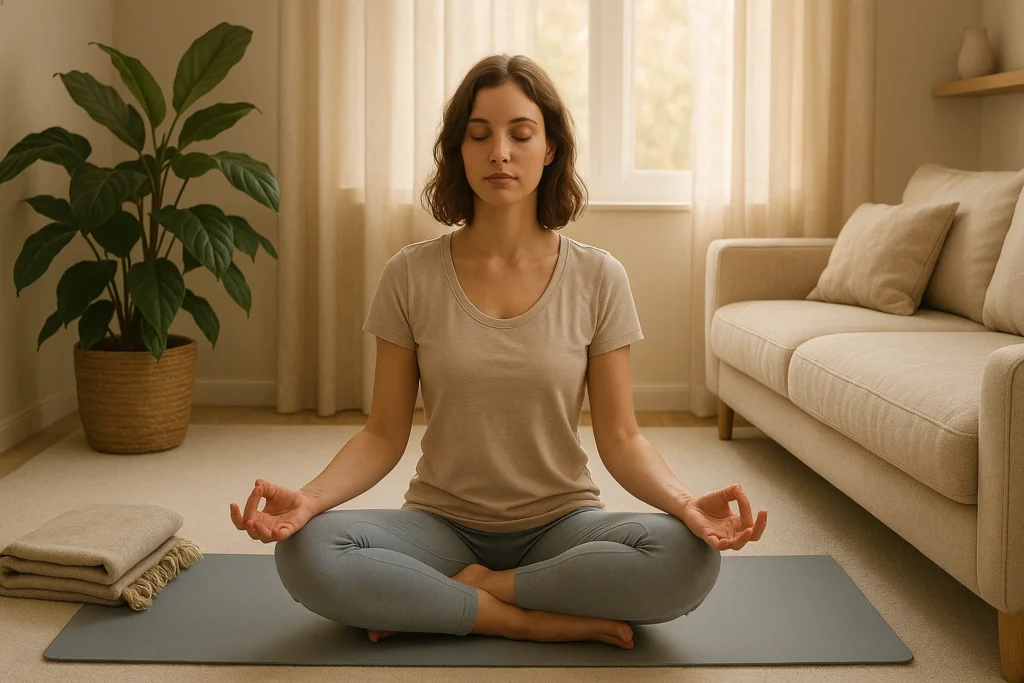
A yoga and Ayurveda center blends yoga, breathwork, and Ayurvedic care to help support balance and clarity. If you’re weighing a retreat—what’s included, what it costs, and how to choose—start with our comprehensive yoga retreat guide.
Start Your Wellness Journey!Table of Contents
- What Is a Holistic Yoga–Ayurveda Center?
- Core Offerings
- How Yoga and Ayurveda Work Together
- Benefits of Integrated Wellness
- Who Can Benefit?
- Wellness Program Quiz
- What to Expect on Your First Visit
- Real-Life Stories
- How to Choose the Right Center
- Frequently Asked Questions
- Conclusion: Your Path to Holistic Wellness
What is a Yoga and Ayurveda Center?
Picture a sanctuary where yoga and Ayurveda work together to support your body, mind, and spirit. These centers focus on whole-person care, drawing on India’s long-standing traditions. Grounded in Vedic texts, the practices are used today to support balance in everyday life. Here’s what typically sets them apart.
Yoga Explained
Yoga isn’t just stretching. It includes postures, breathing practices, and meditation—as well as simple principles that shape how you live. The aim is a steadier body and a quieter mind.
Ayurveda: The Science of Life
Ayurveda, the “science of life,” is a traditional system of care. It aims to balance mind, body, and spirit with personalized diet, herbs, and therapies based on your unique dosha. Paired with yoga, many people find it supports feeling and functioning better.
Core Offerings at a Yoga and Ayurveda Center
Curious what a center like this actually offers? Below are the core services people use most to recharge and stay well:
Daily Yoga Classes 🧘♀️
Yoga is the core of the schedule, and classes are taught with attention to mindful movement benefits:
- Class variety: From gentle Hatha to upbeat Vinyasa, you can match the session to your energy.
- Dosha-aware sequencing: Instructors choose poses with Ayurveda in mind—grounding for Vata, cooling for Pitta, and energizing for Kapha.
- Beyond the poses: Sessions often include breathwork, short meditations, and time to reset.
- Body-first approach: The focus is on how you feel, not on perfect shapes.
Personalized Ayurvedic Consultations 🌿
This is where it gets personal. A trained practitioner digs into your unique makeup. See what current research says about Ayurveda. Want to keep it going? Try an Ayurvedic daily routine.
- Find Your Dosha: Learn your mind-body type (Vata, Pitta, Kapha) and what makes you tick:
- Vata (Air & Ether): Creative, maybe anxious, with dry skin.
- Pitta (Fire & Water): Driven, sometimes fiery, prone to inflammation.
- Kapha (Earth & Water): Chill, but maybe sluggish or carrying extra weight.
- Deep Dive: Think pulse checks, tongue analysis, and chats about your diet and stress.
- Your Plan: Walk away with a custom roadmap—food, lifestyle, herbs, and yoga tips.
This post has affiliate links. We may earn a commission. Learn more.
Detox and Rejuvenation Programs ✨
Feeling due for a reset? Some people try short, guided detox programs to feel lighter and more refreshed. Early research around Panchakarma points to possible well-being gains, but the evidence is still limited and results vary a lot person to person. It’s best to talk through options with a qualified practitioner who knows your history.
- Panchakarma: A series of therapies—such as oil massage and gentle cleansing—traditionally described as reducing “ama” (impurities). Talk with a qualified practitioner about whether it’s appropriate for you.
- Seasonal Cleanses: Gentle resets to sync with nature’s shifts.
- Rejuvenation (Rasayana): Nourishing treatments to support energy and longevity.
Herbal Therapies and Nutrition 🍎
Ayurveda sees food and herbs as medicine:
- Commonly used herbs: Many people use ashwagandha for stress support and turmeric for comfort around inflammation—ask a practitioner what fits you.
- Your Food Plan: Learn what foods suit your dosha and how to eat with intention, mixing sweet, sour, salty, pungent, bitter, and astringent tastes.
Workshops and Retreats 🧘♂️
Ready to go deeper? Many centers host immersive programs like Ayurvedic yoga retreats. At an ayurveda yoga hub, these often include themed weekends, small-group intensives, and beginner-friendly tracks:
- Cooking Classes: Cook simple meals that help balance your dosha.
- Stress Busters: Learn meditation and breathwork techniques you can actually use.
- Philosophy Chats: Explore ancient yoga texts together and relate them to everyday life.
- Weekend Getaways: Take a breather—quiet setting, supportive group, zero pressure.
Wellness Program Quiz
Question 1: How would you describe your energy most days?
Question 2: How do you react to stress?
Question 3: How’s your digestion?
Question 4: What’s your body type like?
Your Result

How Yoga and Ayurveda Work Together
In day-to-day practice, the two meet in simple ways. Yoga helps steady the nervous system and build awareness; Ayurveda shapes your meals and routines so that steadiness is easier to keep. When your doshas feel a bit steadier, many people notice they’re more in sync. Here’s how they team up:
- Ayurveda Guides Yoga: Your dosha shapes your yoga—grounding poses for airy Vatas, lively flows for heavy Kaphas.
- Yoga Boosts Ayurveda: Poses and breathwork prep your body for treatments, which may help you feel more receptive to care.
- Whole-Person Care: Yoga builds awareness and steadiness; Ayurveda focuses on individualized routines.
- Long-Term Habits: Together, they may help address contributing lifestyle factors.
Benefits You Can Expect from Holistic Wellness Centers
Feeling overwhelmed or low on energy? Compared with single-style studios, holistic wellness centers bring movement, breathwork, and individualized Ayurvedic guidance together. Here’s how:
Physical Balance
- May Support Digestion: Ayurvedic eating and yoga practices can help you feel more comfortable.
- Energy Support: Seasonal routines and dosha-aware choices may help you feel more energized.
- Overall Well-Being: Consistent routines support general wellness; this isn’t a claim to prevent or treat illness.
- Sleep Support: Calming practices may encourage more restful sleep.
- Comfort & Mobility: Gentle movement may ease stiffness; discuss ongoing pain with a clinician.
Mental Clarity
- Stress Relief: Meditation and therapies can help calm your nervous system.
- Sharper Focus: Regular practice may help clear mental fog.
- Steady Emotions: Learn to navigate your feelings with more ease.
- Mood Lift: Movement and supportive care may help with everyday low moods.
Spiritual Growth
- Self-Awareness: Get to know your body and mind better.
- Inner Peace: Find calm, no matter what’s going on.
- Connection: Rediscover your true self.
- Harmony: Align mind, body, and spirit for a fuller life.
Who Can Benefit from Holistic Yoga and Ayurveda Programs?
Who benefits in practice? If you’re unsure, start with our dosha quiz and then check the notes below:
- New to yoga: Expect clear instruction, slower pacing, and options for every pose.
- Experienced practitioners: Get tailored sequencing and feedback to refine your practice.
- High-stress schedules: Short breathwork and meditation help downshift fast.
- Managing symptoms: Gentle movement and routine tweaks may support digestion, pain, or fatigue.
- Staying well: Simple daily habits may help prevent burnout and keep energy steadier.
Who Might Not Benefit?
Most folks thrive, but if you’ve got serious health issues (like heart conditions), talk to a doctor before diving into intense programs like Panchakarma. Always pair holistic care with medical advice for big stuff.
What to Expect at a Yoga and Ayurveda Center
Curious about your first step? Here’s what typically happens at an Ayurvedic wellness center:
- Meet Your Guide: Chat with a practitioner about your health, lifestyle, and what you’d like help with. Expect pulse and tongue checks.
- Dosha Deep-Dive: Figure out your unique makeup and what’s off-balance.
- Your Roadmap: Get a custom plan with diet, yoga, and therapy tips.
- Tour the space: See the studio, treatment rooms, and where herbs are prepared.
- Get started: Begin classes or therapies, with check-ins as you go.
Real-Life Transformations
Three short snapshots of how integrated yoga and Ayurveda support can look in real life—common outcomes you might see at an ayurveda yoga hub:
- Sarah, 45: Juggling work and family, she felt overwhelmed and bloated. After a Pitta-calming plan—cooling meals, restorative yoga, and Abhyanga—she reports more settled digestion, less day-to-day anxiety, and more consistent sleep.
- Mark, 60: Joint discomfort and low energy kept him off the trails. A Kapha-focused plan—lively yoga, warming foods, and Pizhichil—he noted rebuilding strength and getting back to weekend hikes with fewer knee flare-ups.
- Lila, 30: New to both systems, she started with beginner classes and a Vata-balancing consult. She left feeling steadier and with a simple daily mindfulness routine she could stick to.
How to Choose the Right Center
Finding your spot is key. Use this wellness center guide to compare options before you decide:
Wellness Center Guide
- Credentials: Look for qualified Ayurvedic practitioners (e.g., BAMS) and experienced yoga teachers.
- Reviews that ring true: Read recent feedback from people with needs like yours.
- Personalization: Programs should be tailored to your dosha and goals, not one-size-fits-all.
- Space & hygiene: Visit if you can; the environment should feel calm and clean.
- Pricing & what’s included: Ask about services, costs, and any add-ons.
- Follow-up support: Make sure there’s guidance after treatments end.
- Red flags: Be cautious of quick-fix promises or unclear credentials.
Frequently Asked Questions
Conclusion: Your Path to Holistic Wellness
Ready to feel more like yourself? Visiting a yoga and Ayurveda center may help you rebuild balance step by step. Most people leave with a realistic plan—think a 10-minute morning sequence, one breathing practice for stressful days, and a couple of easy meal tweaks—they can stick with.


